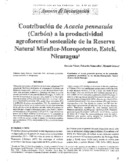| dc.description.abstract | Utilizando entrevistas a 81 familias, un inventario poblacional (175 parcelas de 50x50 m) y mediciones de la biomasa de 40 árboles con diámetros basales entre 2-40 cm, se estudió el conocimiento local, valor, usos, potencial productivo y financiero del árbol de carbón (Acacia pennatula) en los potreros Estelí, Nicaragua. Se utiliza un total de 29 especies de la zona para leña, siendo las de mayor preferencia el carbón (33 por ciento), roble encino (Quercus segoviensis, 13 por ciento), arco (Apoplanesia paniculata, 10 por ciento), guaba (Inga oerstediana, 9 por ciento) y quebracho (Lysiloma microphyllum, 7 por ciento). Se encontraron 240 árboles de carbón ha-1 en los potreros con una alta representación de los árboles menor que 4 cm de diámetro del tallo (48 por ciento). Ecuaciones de regresión para estimar la biomasa de postes, leña, forraje y biomasa total mostraron R2 superiores a 0.8 (p menor que 0.01). La producción de postes dio la mejor relación beneficio/costo (2.44) utilizando un turno de aprovechamiento de 19 años. La cadena de comercialización de leña de carbón produjo márgenes de utilidades positivos para productores (22 por ciento), transportistas (33 por ciento) y detallistas finales (40-49 por ciento). Using a survey of 81 families, an inventory of the tree population (175 plots of 50 x 50 m) and biomass measurements of 40 trees with a basal diameter between 2-40 cm, a study was made of local knowledge, value, use, productive and economic potential of the tree, carbon (Acacia pennatula), in pastures in Esteli, Nicaragua. A total of 29 tree species are used for firewood in this area with the preferred species being carbón (33 percent), Quercus segoviensis (13 percent), Apoplanesia paniculata (10 percent), Inga orstediana (9 percent) and Lysiloma macrophyllum (7 percent). Tree density in pastures was 240 trees ha-1 with a high representation of trees less than 4 cm stem diameter (48 percent). Regression equations for total biomass, fencepost, fuelwood and fodder, had R2 greater then 0.8 (p menor que 0.01). Fencepost production gave the greatest cost/benefit ratio (2.44) for a period of return of 19 years. The commercialization chain for carbon fuelwood gave positive utility margins for producers (25 percent) truckers (33 percent) and local salesmen (40-49 percent). | es_ES |


